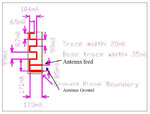Sherif8
Newbie level 5

Dear All,
I need to plot a layout for the antenna of this module RN-171. There are many ways to do this, i want to try the PCB Trace, the datasheet says it should be 4 layers PCB so that i can do this! While my PCB is just 2, i came here to ask if there any other considerations haven't been mentioned in the datasheet concerning the 2 layers!
Thanks,
Sherif
I need to plot a layout for the antenna of this module RN-171. There are many ways to do this, i want to try the PCB Trace, the datasheet says it should be 4 layers PCB so that i can do this! While my PCB is just 2, i came here to ask if there any other considerations haven't been mentioned in the datasheet concerning the 2 layers!
Thanks,
Sherif







